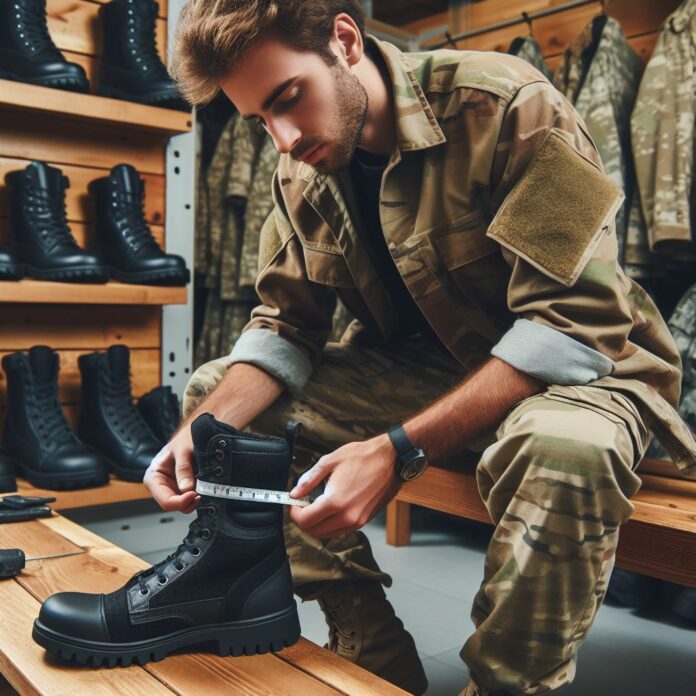Sizing tactical boots properly is essential for optimal comfort, performance, and foot health. Whether you’re a military professional, law enforcement officer, outdoor enthusiast, or simply looking for durable footwear, knowing how to size tactical boots is crucial.
In this article, we will delve into the importance of properly sized tactical boots, explore different measurement methods, provide tips for finding the right fit, address common sizing issues, and discuss how to test and evaluate boots for the perfect fit.
Wearing appropriately sized tactical boots is more than just a matter of convenience. It directly affects your comfort and performance during demanding activities and long hours on your feet.
Ill-fitting boots can lead to discomfort, blisters, and even contribute to a higher risk of foot injuries such as sprains and stress fractures. Conversely, properly sized boots can provide the necessary support, stability, and protection for your feet to perform at their best.
To determine the correct size for tactical boots, several measurement methods can be utilized. The Brannock Device, a foot tracing method, and shoe size conversion charts are commonly used options. Each method provides valuable information to help you select the right size and achieve an optimal fit for your feet.
Finding the right fit involves more than just knowing your foot measurements. Factors such as brand and model variations, specific boot fit characteristics, and even the type of socks and insoles you plan to use should be considered. Taking these factors into account will help you select the most suitable size and ensure a comfortable fit that accommodates your needs.
Sizing issues are common when it comes to tactical boots. Some individuals may have narrow or wide feet, high arches, flat feet, or require extra toe box space. Understanding these specific needs and exploring potential solutions tailored to your requirements is crucial for finding a well-fitting boot that meets your unique foot characteristics.
Once you have narrowed down the options, it is crucial to try on and test the tactical boots before making a final decision. Walking, flexing, checking for heel slippage, and evaluating overall comfort will give you a better sense of how the boots will perform during real-world use.
Importance of Properly Sized Tactical Boots
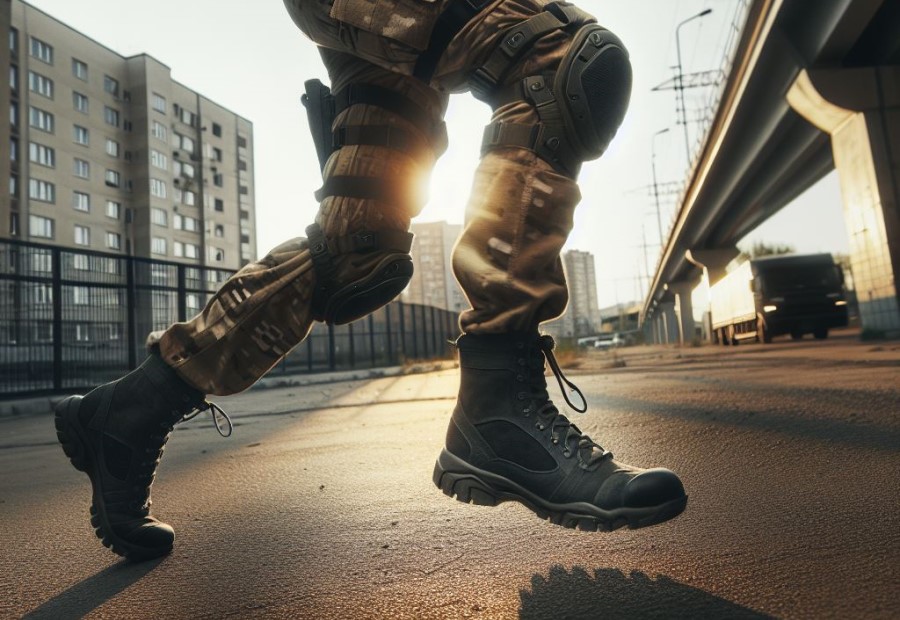
Properly sized tactical boots are more than just a matter of comfort – they play a crucial role in enhancing performance and preventing foot injuries. In this section, we’ll uncover the importance of wearing boots that fit just right.
From the impact on overall comfort and the ability to perform at your best, to the crucial role they play in preventing foot injuries, we’ll explore the significance of finding the perfect fit for your tactical boots.
Comfort and Performance
When it comes to sizing tactical boots, comfort and performance are essential factors to consider.
- A well-fitting boot provides optimal comfort, ensuring ease of movement and reducing the risk of discomfort or pain during long periods of wear.
- Additionally, a comfortable boot enhances performance by ensuring stability and agility, enabling the wearer to maintain focus and react quickly in tactical situations.
- Furthermore, it is crucial to avoid ill-fitting boots, as they can cause blisters, hotspots, and even foot injuries, compromising both comfort and performance.
- To minimize stress on the feet and prevent fatigue, it is important to select boots that offer proper arch support and cushioning.
- Moreover, tactical boots should have a sufficient toe box space to allow for natural movement and prevent discomfort or pain.
Optimizing comfort and performance in tactical boots should be a top priority when making a footwear choice.
Prevention of Foot Injuries
Prevention of foot injuries is a crucial aspect when it comes to sizing tactical boots. By ensuring the proper fit and support, you can significantly reduce the risk of foot injuries or discomfort.
- Proper alignment is essential for the prevention of foot injuries. Well-fitted tactical boots help maintain the proper alignment of the feet, ankles, and lower legs. This alignment reduces the strain on joints and ligaments, minimizing the risk of injuries, such as sprains or fractures.
- Shock absorption plays a vital role in preventing foot injuries. High-quality boots with adequate cushioning and shock-absorbing features help absorb the impact of each step, reducing the stress on the feet and lowering the risk of injuries like stress fractures or heel pain.
- Stability and ankle support are necessary for preventing foot injuries. Tactical boots with proper ankle support provide stability and limit excessive ankle movement. This support helps prevent ankle sprains and other injuries caused by twisting or rolling the ankles.
- Sizing tactical boots correctly is crucial for protection from hazards. A snug fit helps prevent debris, water, or other hazards from entering the boots, reducing the risk of cuts, punctures, or infections.
- Preventing blisters and abrasions is essential to avoid foot injuries. Boots that fit properly without excessive friction or pressure points help prevent blisters and abrasions. These types of injuries can be painful and lead to complications if not properly cared for.
Measurement Methods for Sizing Tactical Boots
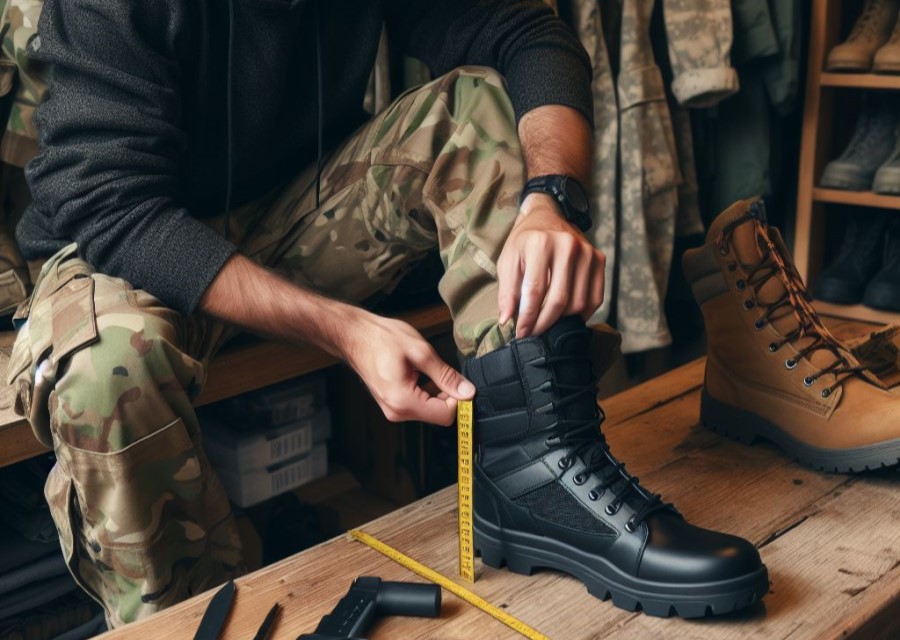
Discover the secrets to accurately sizing tactical boots with different measurement methods. From using the trusted Brannock Device to tracing your foot outline, and navigating shoe size conversion charts, this section will equip you with the knowledge to find the perfect fit. Say goodbye to discomfort and blisters as we dive into the world of tactical boot sizing.
Brannock Device
In the process of sizing tactical boots, the Brannock Device plays a crucial role. This device is specifically designed to measure foot size and width accurately. It consists of a metal contraption with multiple parts that can be adjusted to accommodate different foot sizes.
The Brannock Device is of utmost importance because it allows individuals to determine their precise foot measurements. By taking accurate measurements, they can find the right fit for their tactical boots, ensuring maximum comfort and performance during use.
Using the Brannock Device eliminates guesswork and provides a standardized method for sizing boots. It helps to identify the correct length, width, and arch size, ensuring a proper fit that reduces the risk of foot injuries and discomfort caused by ill-fitting boots.
Without the Brannock Device, determining the correct boot size becomes challenging, leading to potential issues such as blisters, hot spots, and foot pain. By utilizing this measuring tool, individuals can confidently select the right size, enhancing both their comfort and performance in tactical situations.
Foot Tracing
When it comes to sizing tactical boots, foot tracing is a crucial method. Following these steps will help you accurately trace your foot and determine the appropriate boot size:
- To begin, make sure you have a piece of paper that is large enough to accommodate your entire foot.
- Place the paper on a flat, hard surface.
- Position your foot on the paper, ensuring that your heel is firmly against a wall or vertical surface.
- Take a pen or pencil and trace the outline of your foot, keeping it perpendicular to the paper.
- Ensure you trace the entire circumference of your foot, including your toes.
- Apply even pressure while tracing to maintain accuracy.
- Once you remove your foot from the paper, carefully examine the traced outline.
- Measure the length from your heel to the longest toe on the traced outline.
- Measure the width of the widest part of your foot on the traced outline.
- Compare your measurements to the sizing chart provided by the tactical boot manufacturer.
By utilizing the foot tracing technique, you will be able to find the perfect size of tactical boots that offer both comfort and the necessary support and protection for your activities.
Shoe Size Conversion Charts
| US Size | UK Size | EU Size | Foot Length (in inches) |
| 6 | 5.5 | 39 | 9.25 |
| 7 | 6.5 | 40 | 9.625 |
| 8 | 7.5 | 41 | 10 |
| 9 | 8.5 | 42 | 10.375 |
| 10 | 9.5 | 43 | 10.75 |
Shoe size conversion charts provide a helpful way to translate shoe sizes from one system to another. For example, if you know your US shoe size, you can use a conversion chart to find the corresponding UK or EU size. These charts typically include the US size, UK size, EU size, and foot length in inches. It’s important to note that shoe sizes can vary between brands, so it’s always a good idea to consult the specific brand’s size chart for the most accurate fit.
Prior to the standardization of shoe sizes, people used various systems to determine their shoe sizes. The development of shoe size conversion charts streamlined the process of finding the right fit, making it easier for consumers to purchase shoes from different countries or regions. Today, these shoe size conversion charts are widely used and recognized, ensuring that people can easily find the appropriate shoe size no matter where they are in the world.
Tips for Finding the Right Fit
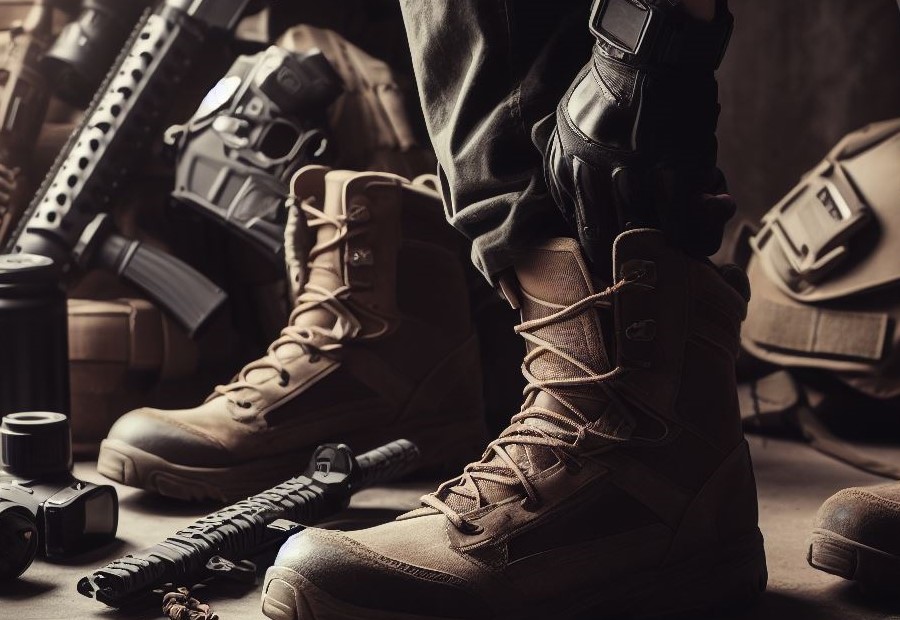
Finding the perfect fit for tactical boots is essential for comfort and performance. In this section, we’ll explore some valuable tips to help you in your quest for the right boot size.
From considering different brands and models to understanding the specifics of boot fit, and taking into account socks and insoles, we’ll cover all the essential factors to ensure a comfortable and secure fit.
So, let’s dive in and find the boots that will support you on any mission or outdoor adventure!
Consider Different Brands and Models
When considering different brands and models of tactical boots, follow these steps:
- Research reputable brands: Look for brands that are known for their quality and durability in the tactical footwear industry. Examples include Salomon, Merrell, and Bates.
- Read customer reviews: Take the time to read reviews from other customers who have purchased the specific brand and model you are interested in. Pay attention to feedback on comfort, fit, and overall performance.
- Consider the intended use: Different brands and models may cater to specific purposes or environments. Determine if the boots you are considering are suitable for your intended use, whether it’s military operations, hiking, or law enforcement.
- Visit a physical store: If possible, try on different brands and models in person. This will allow you to assess the fit, comfort, and overall feel of the boots. Keep in mind that sizes may vary slightly between brands.
- Compare features: Look for specific features that may be important to you, such as waterproofing, ankle support, or traction. Consider whether these features align with your needs and preferences.
- Consider your budget: Tactical boots can vary significantly in price. Determine a budget range that you are comfortable with and focus on brands and models within that range.
- Consult with professionals: If you have specific requirements or concerns about your feet, such as high arches or wide feet, it may be beneficial to consult with a podiatrist or expert in footwear. They can provide guidance on brands and models that may be more suitable for your needs.
Understand the Specifics of Boot Fit
To understand the specifics of boot fit, follow these steps:
- Begin by measuring your feet using a Brannock device or by tracing your feet on a piece of paper to get an accurate measurement.
- Consider both the length and width measurements to determine your proper shoe size, ensuring the perfect fit.
- If you are purchasing boots from a different region or unsure about the sizing system, consult a shoe size conversion chart to ensure accurate sizing.
- Experiment with different brands and models of tactical boots, paying close attention to how they fit your feet to find the best match.
- Focus on the specific features of boot fit, including the snugness around the heel and the flexibility of the toe box.
- Take into consideration the thickness of your socks and any additional insoles that you might use with the boots.
- Keep in mind that depending on your foot structure, such as narrow or wide feet, high arches or flat feet, or the need for extra toe box space, different individuals may have specific fit needs.
- Once you have found a pair of boots that fit well, take a walk and flex your feet to ensure comfort and mobility.
- Pay attention to heel slippage, as excessive slippage can lead to blisters and discomfort, especially during extended use.
- Assess the overall comfort level of the boots by wearing them for an extended period and engaging in activities relevant to your intended use.
Take into Account Socks and Insoles
When sizing tactical boots, it is important to take into account socks and insoles. Here are some factors to consider:
- Sock thickness: Different sock thicknesses can affect the overall fit of the boot. Thicker socks may require a larger boot size to accommodate the extra bulk, while thinner socks may allow for a more snug fit.
- Insole customization: Insoles can play a significant role in comfort and support. Depending on your foot shape and any specific orthotic needs, you may need to choose boots that have removable and replaceable insoles or ones that can accommodate custom orthotics.
- Moisture-wicking properties: Look for socks and insoles that have moisture-wicking properties to help keep your feet dry and prevent discomfort or blisters during extended wear.
- Temperature regulation: Consider the climate conditions in which you’ll be wearing the boots. If you anticipate hot environments, choose moisture-wicking socks and breathable insoles to keep your feet cool. For colder conditions, consider thermal or insulating socks and insoles for added warmth.
- Arch support: Socks and insoles with arch support can provide added comfort and stability. If you have high arches or flat feet, choose socks and insoles that offer appropriate support to prevent discomfort or potential injuries.
Common Sizing Issues and Solutions
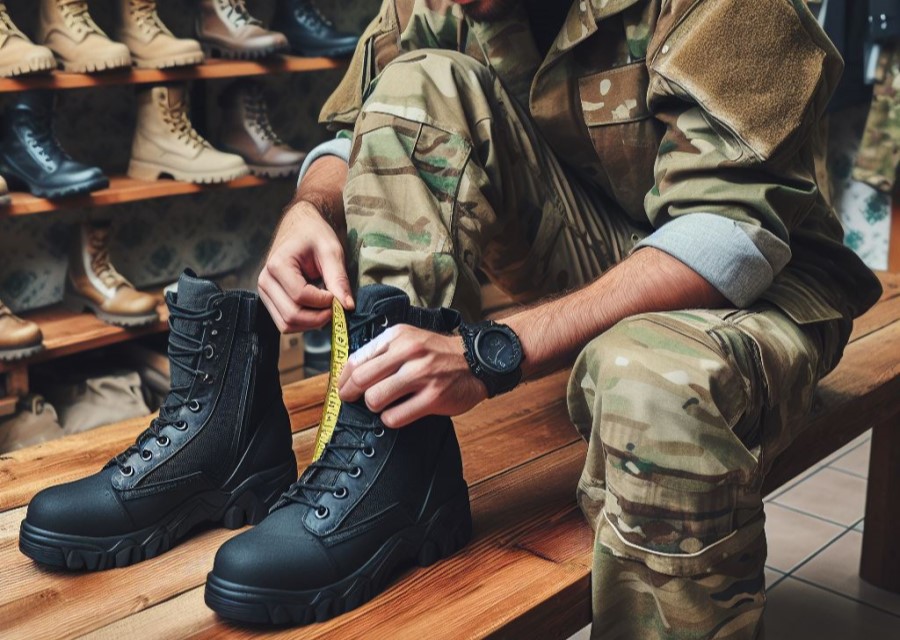
Dealing with the right size of tactical boots can be quite a challenge, especially when you have specific foot characteristics.
In this section, we’ll address some common sizing issues that many individuals face, such as narrow or wide feet, high arches or flat feet, and the importance of having enough toe box space.
Get ready to discover solutions that will ensure your tactical boots fit like a glove, providing comfort and functionality in any situation.
Narrow or Wide Feet
When it comes to sizing tactical boots, it is essential to consider the width of your feet, whether you have narrow or wide feet. Here are some factors to consider:
- Boot width options: Look for boot brands that offer various width options, such as narrow, regular, and wide. By choosing a boot with the appropriate width, you can ensure a better fit for your feet.
- Try different brands: Some brands are known to have narrower or wider fits. It’s worth experimenting with different brands to find one that suits your foot width.
- Seek adjustable features: Tactical boots with lacing systems or straps that can be adjusted can accommodate both narrow and wide feet. Look for boots with these adjustable features to achieve a more customized fit.
- Consider boot material: When selecting tactical boots, keep in mind that certain materials, such as leather, have more flexibility and can accommodate wider feet. On the other hand, synthetic materials may be more forgiving for narrow feet.
- Consult a professional: If you’re uncertain about your foot width, consider consulting a professional or using a foot measuring device to determine the exact measurements. This will help you make an informed decision.
Remember, finding the right fit is crucial for comfort, performance, and preventing foot injuries. This is especially true if you have narrow or wide feet. By considering these factors, you can confidently choose tactical boots that provide the perfect fit for your specific foot width.
High Arches or Flat Feet
When it comes to sizing tactical boots, individuals with high arches or flat feet may face specific challenges. It is important to consider these factors to ensure a proper fit and maximum comfort.
- High Arches: For those with high arches, it is important to find boots with proper arch support. Look for boots that offer cushioning and stability to alleviate pressure on the arches. Consider orthotic inserts to provide additional support and enhance comfort.
- Flat Feet: Individuals with flat feet should opt for boots with good arch support and stability. Look for boots with built-in arch support or use orthotic inserts to provide the necessary support. Additionally, choose boots with a supportive and cushioned sole to help distribute weight evenly.
Toe Box Space
The toe box space is a crucial factor to take into consideration when determining the size of tactical boots. It is essentially the area at the front of the boot where your toes are positioned. Here are some important points to remember:
- Adequate room: It is important to ensure that the toe box provides enough space for your toes to comfortably move around. This is vital for maintaining proper circulation and avoiding discomfort or injuries during extended periods of wearing.
- Toe protection: The toe box should also offer sufficient protection for your toes. Look for boots that have reinforced toe caps or other safety features to shield your toes from impacts or compression.
- Proper fit: It is essential to find a boot with a toe box that suits the shape and size of your feet. Different brands may have different toe box widths, so try out various options to find the best fit for you.
- Consider your foot type: If you have wider feet or bunions, opt for boots with a wider toe box to prevent constriction. On the other hand, if you have narrow feet, look for boots with a narrower toe box to avoid excessive movement and discomfort.
Pro-tip: When trying on tactical boots, make sure to wear the same type of socks and insoles that you plan to use during actual wear. This will give you a more accurate sense of how the toe box space will feel in real-life conditions.
Trying on and Testing Tactical Boots

Ready to find the perfect tactical boots? In this section, we’ll dive into the exciting process of trying on and testing them.
Discover the secrets of finding boots that let you walk and flex effortlessly, without any heel slippage.
Plus, we’ll reveal the key to evaluating the comfort level for all-day wear.
Say goodbye to ill-fitting boots and hello to superior performance.
Get ready for a boot-fitting adventure like no other!
Walking and Flexing
When sizing tactical boots, it is crucial to assess their comfort and performance by actively engaging in activities such as walking and flexing. These actions allow you to evaluate how well the boots conform to your feet and how they function during movement.
While walking, it is important to pay close attention to any discomfort or rubbing that may occur. It is also recommendable to flex your feet to determine if the boots provide sufficient flexibility and mobility. Adequate flexing ensures that your feet can move naturally and comfortably.
Additionally, it is essential to observe whether the boots deliver the necessary support and stability during these movements. By carefully evaluating how the boots perform during walking and flexing, you can ensure that they meet your needs and do not cause any discomfort or hinder your performance in tactical situations.
Always keep in mind that comfort and functionality are key factors to consider when selecting the right tactical boots.
Checking for Heel Slippage
When sizing tactical boots, checking for heel slippage is an important step to ensure a proper fit. This can be done by testing the boots in the following ways:
- Walk and flex: Take a few steps in the boots to see how they feel. Pay attention to any slipping or sliding of the heel.
- Check for heel slippage: Apply pressure to the back of the boots to see if the heel moves up and down. If there is significant slippage, the boots may be too big.
- Evaluate comfort level: Assess how comfortable the boots feel overall. Heel slippage can cause discomfort and affect the performance of the boots.
When checking for heel slippage, it is important to remember that a small amount of movement is normal, especially during the break-in period. However, if the slippage is excessive and causes discomfort, it may be necessary to try a different size or style of boots.
When trying on tactical boots, take your time to ensure the best fit for your feet. It is recommended to try on boots with the socks and insoles you intend to wear while using them. This will give you a more accurate idea of how the boots will feel during actual use.
Remember, finding the right fit for tactical boots is crucial for comfort, performance, and preventing foot injuries. Checking for heel slippage is just one of the many steps in the process of selecting the perfect pair of boots.
Evaluating Comfort Level
When evaluating the comfort level of tactical boots, it is important to consider several key factors. These include fit, cushioning, arch support, breathability, flexibility, and weight. Evaluating these aspects will help you find the most comfortable boots for your needs.
- Fit: It is essential to ensure that the boots snugly fit your feet without being too tight or too loose. A proper fit prevents discomfort and blisters.
- Cushioning: Evaluate the amount of cushioning in the boots, especially around the heel and midsole. Sufficient cushioning enhances comfort, reduces impact, and minimizes fatigue.
- Arch Support: Check if the boots provide adequate arch support. This will help distribute weight evenly and reduce strain on the feet.
- Breathability: Look for boots made from breathable materials that allow air circulation. This feature prevents excessive sweating and keeps your feet dry and comfortable.
- Flexibility: Test the flexibility of the boots by walking and flexing your feet. Flexible boots allow for natural foot movement, increasing comfort during long periods of wear.
- Weight: Consider the weight of the boots, as lighter boots are generally more comfortable for extended wear.
Evaluating the comfort level of tactical boots is crucial to ensure long-lasting comfort and performance during activities. Incorporating these elements such as fit, cushioning, arch support, breathability, flexibility, and weight will help you find the most comfortable boots.
Frequently Asked Questions
How do military boot sizes work?
Military boot sizes generally match regular shoe sizes, but sizing can vary between brands. It is recommended to read company suggestions or customer reviews to determine if you should size up or down for certain brands.
What factors should I consider when trying on military boots?
When trying on military boots, it is important to consider factors such as how they fit while standing and walking, the amount of wiggle room for your toes, the fit of the heels, the time of day you try them on, and the socks you will wear with them.
What width option should I choose for military boots?
Military boots offer different width options, including narrow, medium, wide, and extra-wide. It is important to choose a width that fits securely to the sides of your feet to avoid foot problems and increase the longevity of the boots.
How do I convert between men’s and women’s military boot sizes?
When converting between men’s and women’s military boot sizes, it is recommended to go up or down a size-and-a-half. It is important to note that men’s and women’s military boots are designed to suit the general foot shape of each sex, but every foot is different, so it is worth trying on military boots designed for the opposite sex to find the best fit.
What are some boot fitting tips to ensure a proper fit?
Here are some boot fitting tips to ensure a proper fit:
- The entire foot should feel snug except for the heel, which will slip a little in a properly fitted new boot.
- There should be a bit of wiggle room for the toes in the front of the boots to accommodate foot swelling.
- The ball of the foot should sit at the widest part of the sole of the boot.
- Thick socks should be worn when trying on boots as most boots are made to be worn with thick socks and they also protect against blisters.
What type of socks are recommended for wearing with military boots?
Wool/nylon blend socks are recommended for boots as wool can absorb moisture, insulate, dry quickly, and is anti-bacterial and odor resistant. Recommended wool-nylon sock brands for boots include Darn Tough, Carhartt, and Wigwam.

